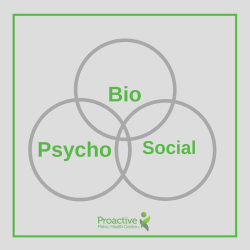Biopsychosocial factors that influence pelvic pain
By Angelique Montano-Bresolin, Reg. PT
We live in a complex world. Technology has allowed for immense industry growth and a faster pace of living. All wonderful progressions forward, but how do these changes affect our lives and the way we manage, experience and recover from pain, ailments and disease?
Our ‘busy bee’ western lifestyle is not always conducive to healing and if it hasn’t already been on your radar, we need to contemplate why there is a very strong uptick in our society for conditions such as chronic pain, fibromyalgia, chronic fatigue syndrome, chronic headaches, IBS…the list goes on.
Our bodies are made to heal but for us to be able to optimize healing, we need to understand the factors at play that can either inhibit or facilitate health and wellness. This is where the complex word ‘biopsychosocial’ comes in.
Yes ‘biopsychosocial’ is a mouthful so what does it even mean and how can it influence our ability to repair and restore our bodies; specifically when it comes to pelvic pain syndromes?
Firstly, we need to acknowledge that there are a myriad of symptoms and presentations when it comes to pelvic pain conditions. Some of these symptoms may include unpleasant sensations such as the feeling of urgency to urinate, burning, pressure in the bladder, abdominal pain, perineal pain, pubic pain, pain with intercourse or pain anywhere in the pelvis.
Research has shown that the presentation of any of these pelvic symptoms can be highly influenced by biological, psychological and social factors in one’s life. Let’s discuss each of these components.
Biological:
This is referring to the biological factors that can affect our pain experience. Some examples of this include:
-Inflammation
-Muscle/tissue dysfunction
-Excessive mechanical pressure on tissues
-The way our central nervous system responds to harmful or potentially harmful stimuli
In a western culture society, we are very familiar with how these biological factors could potentially increase pain and how a western biomedical model of care can help ‘fix’ symptoms (eg. medication, surgery, manual treatment). At times, we put too much emphasis on treating these aspects and may even ignore the relevance of the following two factors.
Psychological:
Psychological factors can affect our pain experience. Some examples of this would be:
-What we belief (such as ‘sex is good/bad’)
-Our thoughts (such as ‘I hate/love….’)
-How we feel at that moment (sad/angry/excited)
-Our understanding of pain (eg. do you know why you are in pain)
It is very important to note that when we are talking about psychological factors, that we do not interpret this as ‘it is all in my head’. Our ability to change our way of thinking, what we believe and how we feel, give us the power to be able to alter our pain experience.
Our brain is a very structural part of our central nervous system and is responsive to learning and retraining. Our brains are ‘plastic’ meaning that even in adulthood, the brain is still highly adaptable and able to rewire the way we think, what we feel and how we do things. The psychological realm is just as real and relevant as the biological realm and in some cases can be the leading driver of pain. So, we cannot continue to ignore its importance.
Social:
Lastly, social factors can impact the pain we feel. This includes:
-Our (healthy/unhealthy) relationships with family, friends and colleagues
-Our satisfaction/stress within our work/home life
-Our (positive or negative) experiences with the healthcare system
-Societal and cultural expectations (‘busy is better’ rather than ‘balance instead of burnout’)
It is normal to experience stresses in our relationships and at work, but unhealthy chronic exposure to high levels of stress can influence how we feel physically. (Read more about how stress influences pain)
As you can see, when it comes to chronic pelvic pain syndromes (as well as with other chronic conditions mentioned above), it is not enough to only consider biological mechanisms at play. Without considering the other components that can contribute to one’s pain experience, our outcomes of treatment may not be as successful.
These biopsychosocial factors overlap, and the unique combination of their presentation in our life will affect the symptoms that we experience. When we are able to identify what contributes to an increase or decrease in pain, we can implement very specific strategies to alter our symptom experience. Looking at chronic pelvic pain syndromes with a more holistic biopsychosocial lens allows us to have better control over recovery and healing.
Should you need help in addressing any of these factors as it pertains to your pelvic pain symptoms, contact one of our pelvic floor physiotherapists today and begin your journey to better health and wellness.
References:
Moseley GL & Butler DS (2017) The Explain Pain Supercharged. Noigroup Publications: Adelaide.
Vandyken, C & Hilton, S. Physical Therapy in the Treatment of Central Pain Mechanisms for Female Sexual Pain. Sex Med Rev 2017;5:20-30.
Hilton, S & Vandyken, C. The Puzzle of Pelvic Pain – A Rehabilitation Framework for Balancing Tissue Dysfunction and Central Sensitization, I: Pain Physiology and Evaluation for the Physical Therapist. Journal of Women’s Health Physical Therapy. September/December 2011, Volume 35, Number 3.


